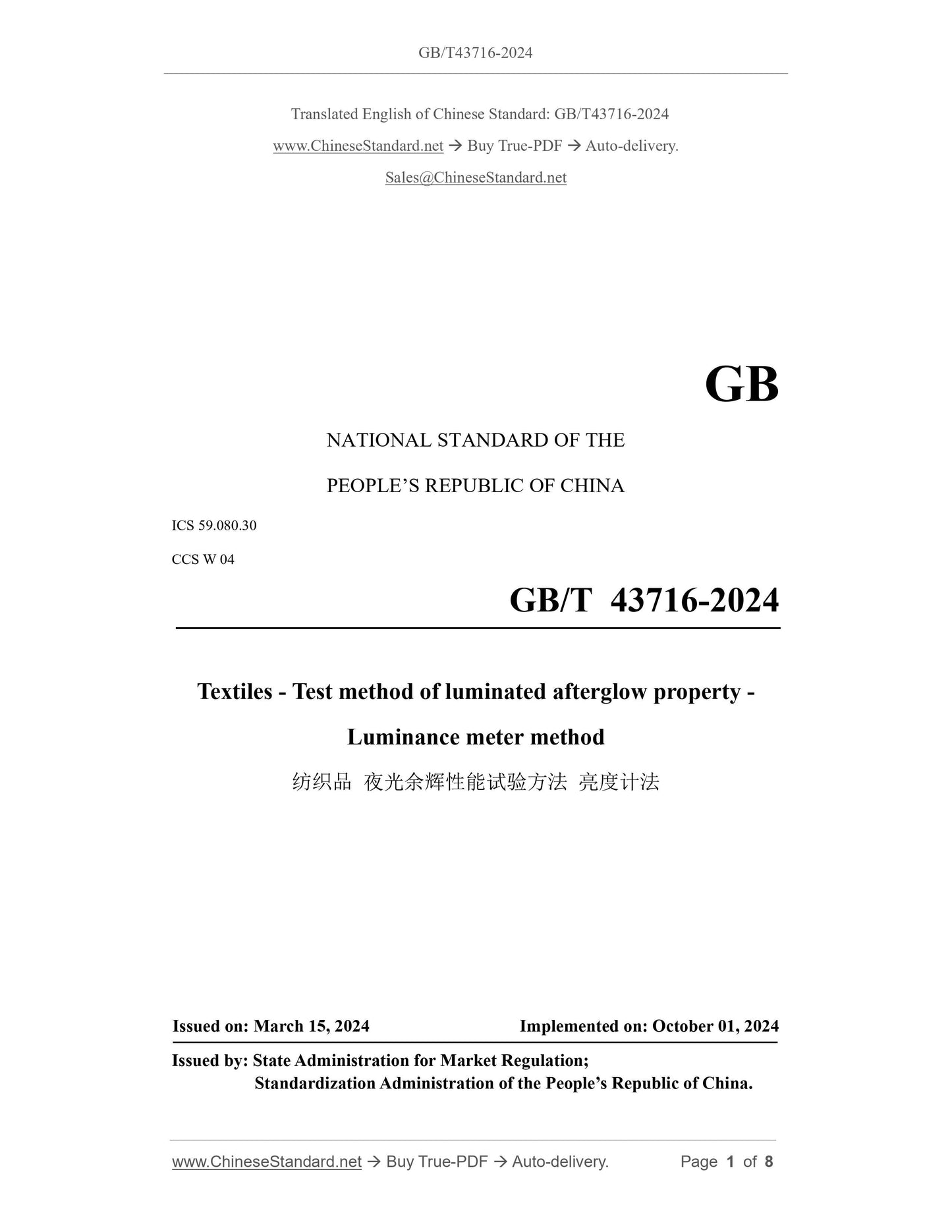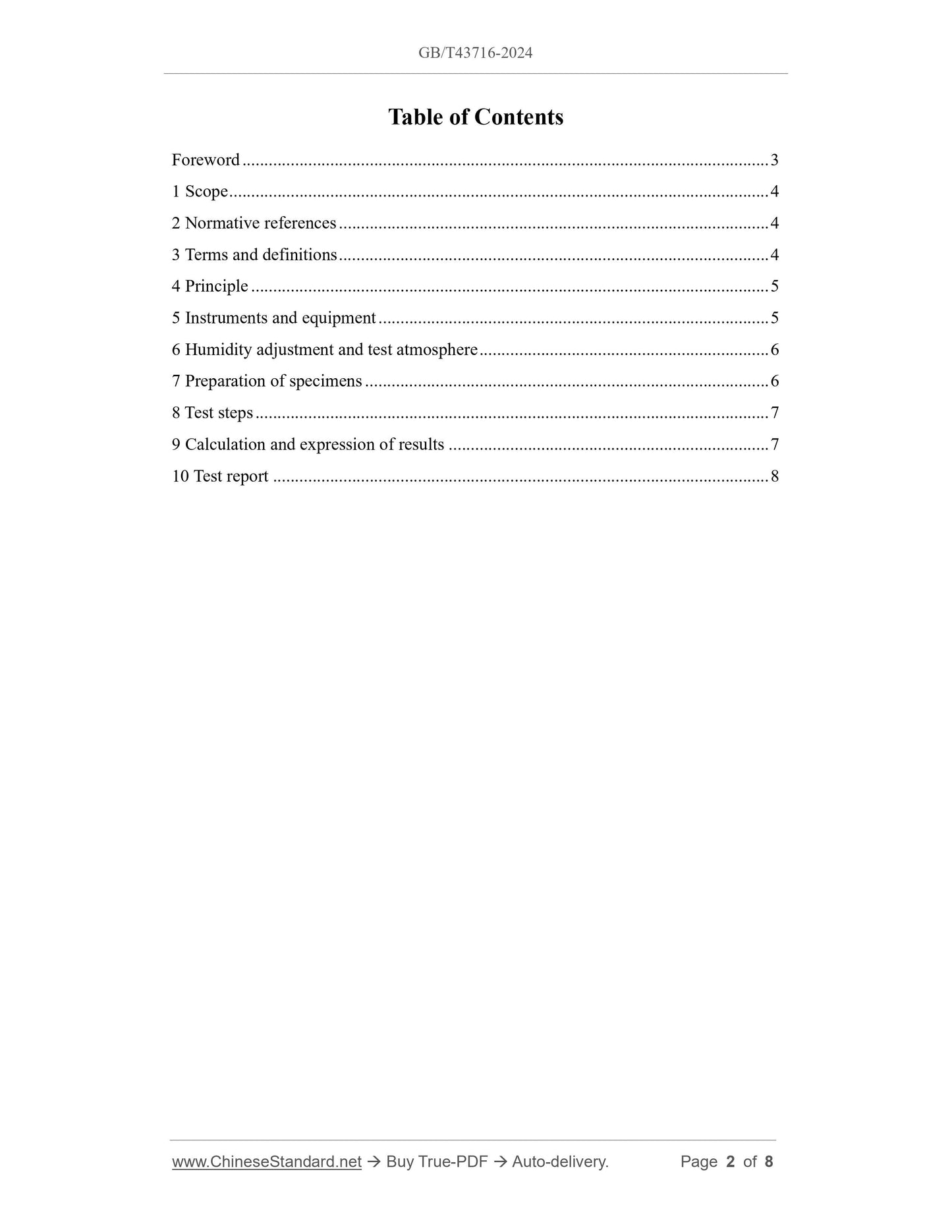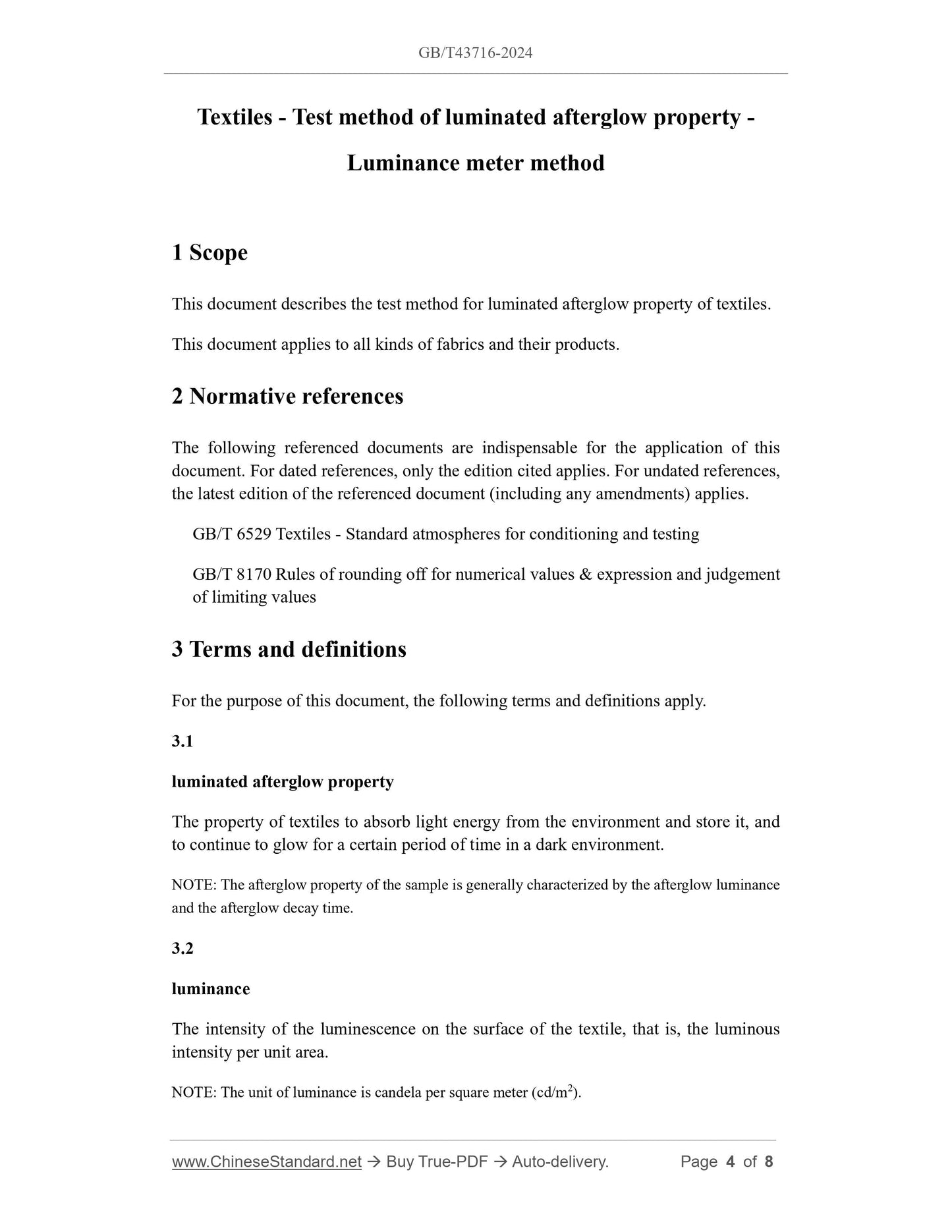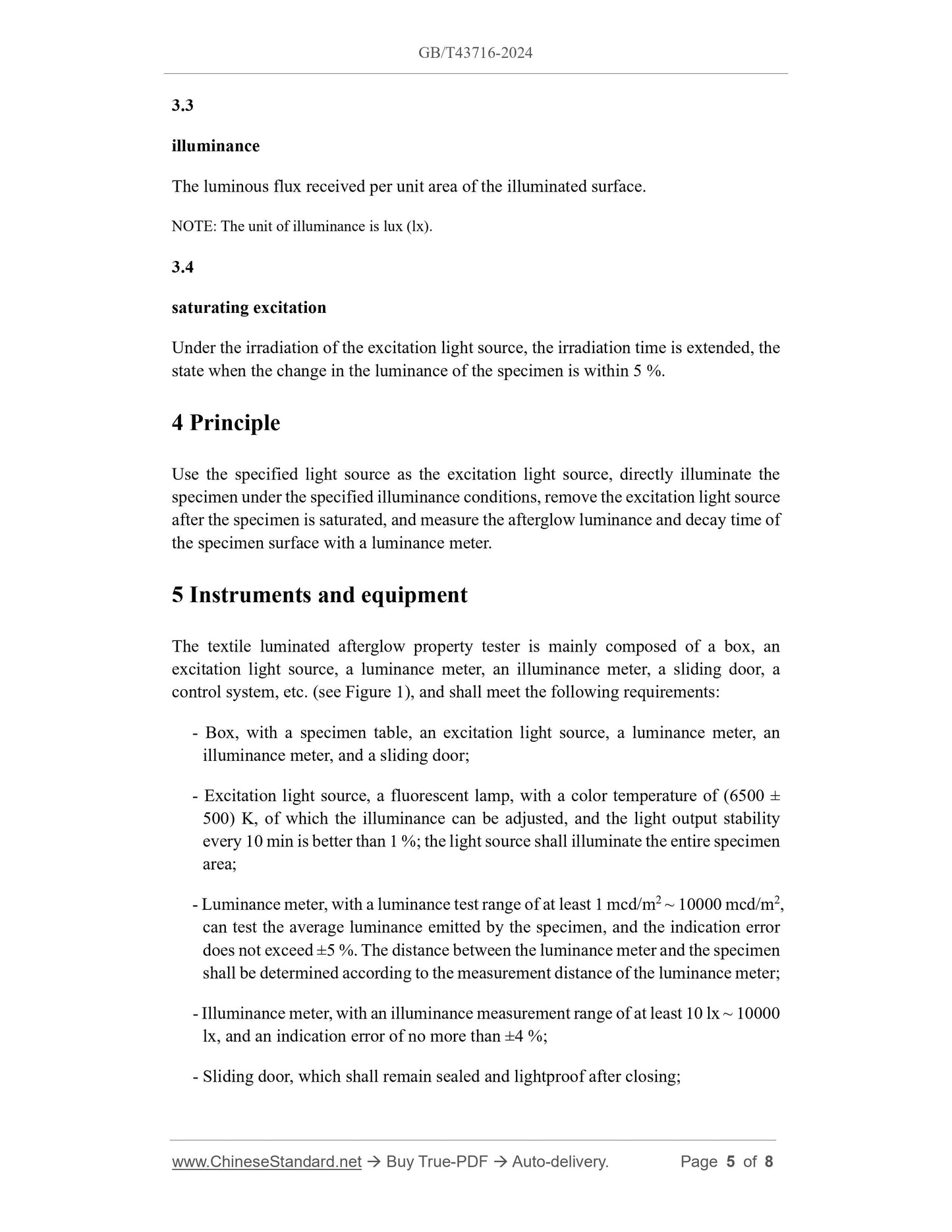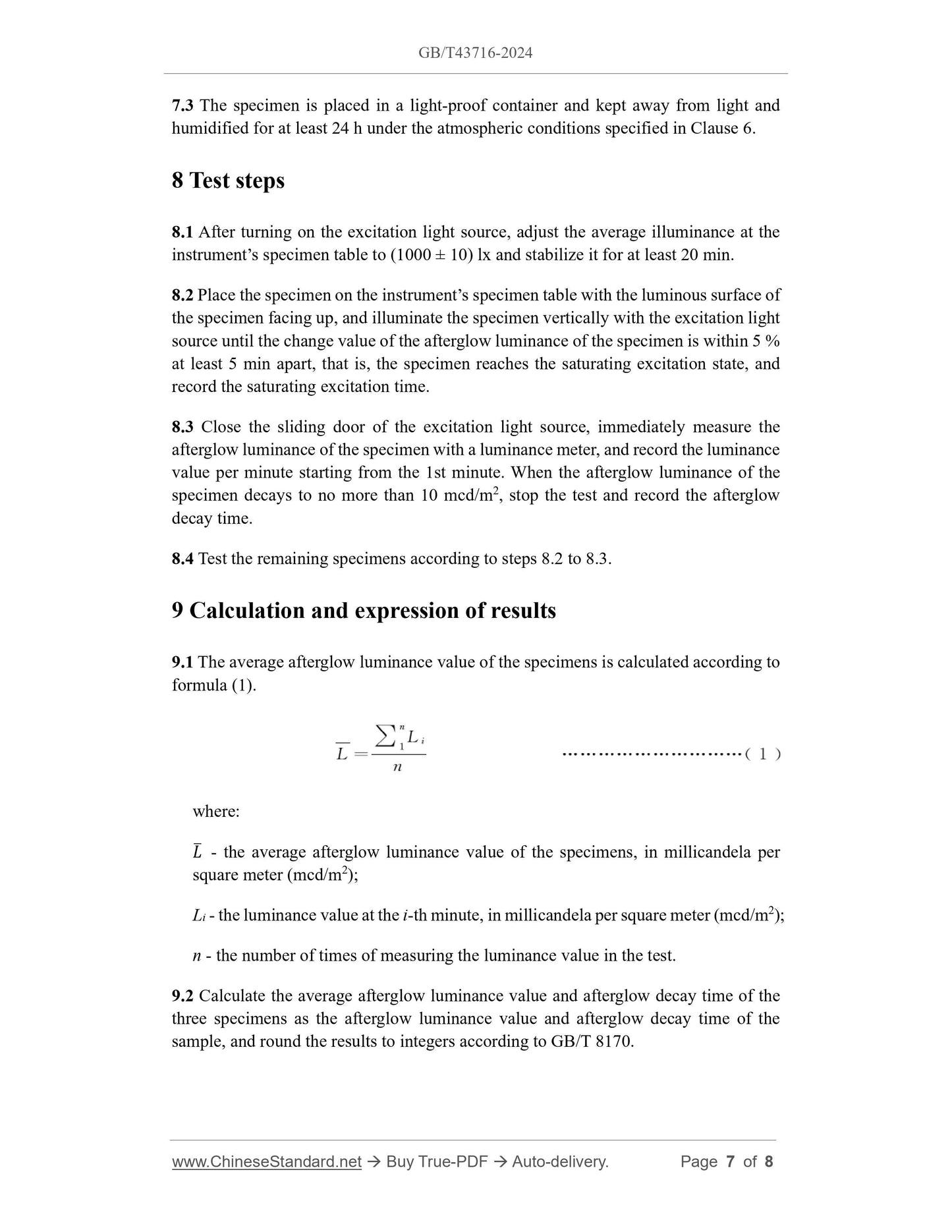1
/
of
5
www.ChineseStandard.us -- Field Test Asia Pte. Ltd.
GB/T 43716-2024 English PDF (GB/T43716-2024)
GB/T 43716-2024 English PDF (GB/T43716-2024)
Regular price
$125.00
Regular price
Sale price
$125.00
Unit price
/
per
Shipping calculated at checkout.
Couldn't load pickup availability
GB/T 43716-2024: Textiles - Test method of luminated afterglow property - Luminance meter method
Delivery: 9 seconds. Download (& Email) true-PDF + Invoice.
Get Quotation: Click GB/T 43716-2024 (Self-service in 1-minute)
Historical versions (Master-website): GB/T 43716-2024
Preview True-PDF (Reload/Scroll-down if blank)
/>GB/T 43716-2024
GB
NATIONAL STANDARD OF THE
PEOPLE’S REPUBLIC OF CHINA
ICS 59.080.30
CCS W 04
GB/T 43716-2024
Textiles - Test method of luminated afterglow property -
Luminance meter method
ISSUED ON: MARCH 15, 2024
IMPLEMENTED ON: OCTOBER 01, 2024
Issued by: State Administration for Market Regulation;
Standardization Administration of the People’s Republic of China.
Table of Contents
Foreword ... 3
1 Scope ... 4
2 Normative references ... 4
3 Terms and definitions ... 4
4 Principle ... 5
5 Instruments and equipment ... 5
6 Humidity adjustment and test atmosphere ... 6
7 Preparation of specimens ... 6
8 Test steps ... 7
9 Calculation and expression of results ... 7
10 Test report ... 8
Textiles - Test method of luminated afterglow property -
Luminance meter method
1 Scope
This document describes the test method for luminated afterglow property of textiles.
This document applies to all kinds of fabrics and their products.
2 Normative references
The following referenced documents are indispensable for the application of this
document. For dated references, only the edition cited applies. For undated references,
the latest edition of the referenced document (including any amendments) applies.
GB/T 6529 Textiles - Standard atmospheres for conditioning and testing
GB/T 8170 Rules of rounding off for numerical values and expression and judgement
of limiting values
3 Terms and definitions
For the purpose of this document, the following terms and definitions apply.
3.1
luminated afterglow property
The property of textiles to absorb light energy from the environment and store it, and
to continue to glow for a certain period of time in a dark environment.
NOTE: The afterglow property of the sample is generally characterized by the afterglow luminance
and the afterglow decay time.
3.2
luminance
The intensity of the luminescence on the surface of the textile, that is, the luminous
intensity per unit area.
NOTE: The unit of luminance is candela per square meter (cd/m2).
3.3
illuminance
The luminous flux received per unit area of the illuminated surface.
NOTE: The unit of illuminance is lux (lx).
3.4
saturating excitation
Under the irradiation of the excitation light source, the irradiation time is extended, the
state when the change in the luminance of the specimen is within 5 %.
4 Principle
Use the specified light source as the excitation light source, directly illuminate the
specimen under the specified illuminance conditions, remove the excitation light source
after the specimen is saturated, and measure the afterglow luminance and decay time of
the specimen surface with a luminance meter.
5 Instruments and equipment
The textile luminated afterglow property tester is mainly composed of a box, an
excitation light source, a luminance meter, an illuminance meter, a sliding door, a
control system, etc. (see Figure 1), and shall meet the following requirements:
- Box, with a specimen table, an excitation light source, a luminance meter, an
illuminance meter, and a sliding door;
- Excitation light source, a fluorescent lamp, with a color temperature of (6500 ±
500) K, of which the illuminance can be adjusted, and the light output stability
every 10 min is better than 1 %; the light source shall illuminate the entire specimen
area;
- Luminance meter, with a luminance test range of at least 1 mcd/m2 ~ 10000 mcd/m2,
can test the average luminance emitted by the specimen, and the indication error
does not exceed ±5 %. The distance between the luminance meter and the specimen
shall be determined according to the measurement distance of the luminance meter;
- Illuminance meter, with an illuminance measurement range of at least 10 lx ~ 10000
lx, and an indication error of no more than ±4 %;
- Sliding door, which shall remain sealed and lightproof after closing;
7.3 The specimen is placed in a light-proof container and kept away from light and
humidified for at least 24 h under the atmospheric conditions specified in Clause 6.
8 Test steps
8.1 After turning on the excitation light source, adjust the average illuminance at the
instrument’s specimen table to (1000 ± 10) lx and stabilize it for at least 20 min.
8.2 Place the specimen on the instrument’s specimen table with the luminous surface of
the specimen facing up, and illuminate the specimen vertically with the excitation light
source until the change value of the afterglow luminance of the specimen is within 5 %
at least 5 min apart, that is, the specimen reaches the saturating excitation state, and
record the saturating excitation time.
8.3 Close the sliding door of the excitation light source, immediately measure the
afterglow luminance of the specimen with a luminance meter, and record the luminance
value per minute starting from the 1st minute. When the afterglow luminance of the
specimen decays to no more than 10 mcd/m2, stop the test and record the afterglow
decay time.
8.4 Test the remaining specimens according to steps 8.2 to 8.3.
9 Calculation and expression of results
9.1 The average afterglow luminance value of the specimens is calculated according to
formula (1).
where:
𝐿ത - the average afterglow luminance value of the specimens, in millicandela per
square meter (mcd/m2);
Li - the luminance value at the i-th minute, in millicandela per square meter (mcd/m2);
n - the number of times of measuring the luminance value in the test.
9.2 Calculate the average afterglow luminance value and afterglow decay time of the
three specimens as the afterglow luminance value and afterglow decay time of the
sample, and round the results to integers according to GB/T 8170.
GB/T 43716-2024
GB
NATIONAL STANDARD OF THE
PEOPLE’S REPUBLIC OF CHINA
ICS 59.080.30
CCS W 04
GB/T 43716-2024
Textiles - Test method of luminated afterglow property -
Luminance meter method
ISSUED ON: MARCH 15, 2024
IMPLEMENTED ON: OCTOBER 01, 2024
Issued by: State Administration for Market Regulation;
Standardization Administration of the People’s Republic of China.
Table of Contents
Foreword ... 3
1 Scope ... 4
2 Normative references ... 4
3 Terms and definitions ... 4
4 Principle ... 5
5 Instruments and equipment ... 5
6 Humidity adjustment and test atmosphere ... 6
7 Preparation of specimens ... 6
8 Test steps ... 7
9 Calculation and expression of results ... 7
10 Test report ... 8
Textiles - Test method of luminated afterglow property -
Luminance meter method
1 Scope
This document describes the test method for luminated afterglow property of textiles.
This document applies to all kinds of fabrics and their products.
2 Normative references
The following referenced documents are indispensable for the application of this
document. For dated references, only the edition cited applies. For undated references,
the latest edition of the referenced document (including any amendments) applies.
GB/T 6529 Textiles - Standard atmospheres for conditioning and testing
GB/T 8170 Rules of rounding off for numerical values and expression and judgement
of limiting values
3 Terms and definitions
For the purpose of this document, the following terms and definitions apply.
3.1
luminated afterglow property
The property of textiles to absorb light energy from the environment and store it, and
to continue to glow for a certain period of time in a dark environment.
NOTE: The afterglow property of the sample is generally characterized by the afterglow luminance
and the afterglow decay time.
3.2
luminance
The intensity of the luminescence on the surface of the textile, that is, the luminous
intensity per unit area.
NOTE: The unit of luminance is candela per square meter (cd/m2).
3.3
illuminance
The luminous flux received per unit area of the illuminated surface.
NOTE: The unit of illuminance is lux (lx).
3.4
saturating excitation
Under the irradiation of the excitation light source, the irradiation time is extended, the
state when the change in the luminance of the specimen is within 5 %.
4 Principle
Use the specified light source as the excitation light source, directly illuminate the
specimen under the specified illuminance conditions, remove the excitation light source
after the specimen is saturated, and measure the afterglow luminance and decay time of
the specimen surface with a luminance meter.
5 Instruments and equipment
The textile luminated afterglow property tester is mainly composed of a box, an
excitation light source, a luminance meter, an illuminance meter, a sliding door, a
control system, etc. (see Figure 1), and shall meet the following requirements:
- Box, with a specimen table, an excitation light source, a luminance meter, an
illuminance meter, and a sliding door;
- Excitation light source, a fluorescent lamp, with a color temperature of (6500 ±
500) K, of which the illuminance can be adjusted, and the light output stability
every 10 min is better than 1 %; the light source shall illuminate the entire specimen
area;
- Luminance meter, with a luminance test range of at least 1 mcd/m2 ~ 10000 mcd/m2,
can test the average luminance emitted by the specimen, and the indication error
does not exceed ±5 %. The distance between the luminance meter and the specimen
shall be determined according to the measurement distance of the luminance meter;
- Illuminance meter, with an illuminance measurement range of at least 10 lx ~ 10000
lx, and an indication error of no more than ±4 %;
- Sliding door, which shall remain sealed and lightproof after closing;
7.3 The specimen is placed in a light-proof container and kept away from light and
humidified for at least 24 h under the atmospheric conditions specified in Clause 6.
8 Test steps
8.1 After turning on the excitation light source, adjust the average illuminance at the
instrument’s specimen table to (1000 ± 10) lx and stabilize it for at least 20 min.
8.2 Place the specimen on the instrument’s specimen table with the luminous surface of
the specimen facing up, and illuminate the specimen vertically with the excitation light
source until the change value of the afterglow luminance of the specimen is within 5 %
at least 5 min apart, that is, the specimen reaches the saturating excitation state, and
record the saturating excitation time.
8.3 Close the sliding door of the excitation light source, immediately measure the
afterglow luminance of the specimen with a luminance meter, and record the luminance
value per minute starting from the 1st minute. When the afterglow luminance of the
specimen decays to no more than 10 mcd/m2, stop the test and record the afterglow
decay time.
8.4 Test the remaining specimens according to steps 8.2 to 8.3.
9 Calculation and expression of results
9.1 The average afterglow luminance value of the specimens is calculated according to
formula (1).
where:
𝐿ത - the average afterglow luminance value of the specimens, in millicandela per
square meter (mcd/m2);
Li - the luminance value at the i-th minute, in millicandela per square meter (mcd/m2);
n - the number of times of measuring the luminance value in the test.
9.2 Calculate the average afterglow luminance value and afterglow decay time of the
three specimens as the afterglow luminance value and afterglow decay time of the
sample, and round the results to integers according to GB/T 8170.
Delivery: 9 seconds. Download (& Email) true-PDF + Invoice.
Get Quotation: Click GB/T 43716-2024 (Self-service in 1-minute)
Historical versions (Master-website): GB/T 43716-2024
Preview True-PDF (Reload/Scroll-down if blank)
/>GB/T 43716-2024
GB
NATIONAL STANDARD OF THE
PEOPLE’S REPUBLIC OF CHINA
ICS 59.080.30
CCS W 04
GB/T 43716-2024
Textiles - Test method of luminated afterglow property -
Luminance meter method
ISSUED ON: MARCH 15, 2024
IMPLEMENTED ON: OCTOBER 01, 2024
Issued by: State Administration for Market Regulation;
Standardization Administration of the People’s Republic of China.
Table of Contents
Foreword ... 3
1 Scope ... 4
2 Normative references ... 4
3 Terms and definitions ... 4
4 Principle ... 5
5 Instruments and equipment ... 5
6 Humidity adjustment and test atmosphere ... 6
7 Preparation of specimens ... 6
8 Test steps ... 7
9 Calculation and expression of results ... 7
10 Test report ... 8
Textiles - Test method of luminated afterglow property -
Luminance meter method
1 Scope
This document describes the test method for luminated afterglow property of textiles.
This document applies to all kinds of fabrics and their products.
2 Normative references
The following referenced documents are indispensable for the application of this
document. For dated references, only the edition cited applies. For undated references,
the latest edition of the referenced document (including any amendments) applies.
GB/T 6529 Textiles - Standard atmospheres for conditioning and testing
GB/T 8170 Rules of rounding off for numerical values and expression and judgement
of limiting values
3 Terms and definitions
For the purpose of this document, the following terms and definitions apply.
3.1
luminated afterglow property
The property of textiles to absorb light energy from the environment and store it, and
to continue to glow for a certain period of time in a dark environment.
NOTE: The afterglow property of the sample is generally characterized by the afterglow luminance
and the afterglow decay time.
3.2
luminance
The intensity of the luminescence on the surface of the textile, that is, the luminous
intensity per unit area.
NOTE: The unit of luminance is candela per square meter (cd/m2).
3.3
illuminance
The luminous flux received per unit area of the illuminated surface.
NOTE: The unit of illuminance is lux (lx).
3.4
saturating excitation
Under the irradiation of the excitation light source, the irradiation time is extended, the
state when the change in the luminance of the specimen is within 5 %.
4 Principle
Use the specified light source as the excitation light source, directly illuminate the
specimen under the specified illuminance conditions, remove the excitation light source
after the specimen is saturated, and measure the afterglow luminance and decay time of
the specimen surface with a luminance meter.
5 Instruments and equipment
The textile luminated afterglow property tester is mainly composed of a box, an
excitation light source, a luminance meter, an illuminance meter, a sliding door, a
control system, etc. (see Figure 1), and shall meet the following requirements:
- Box, with a specimen table, an excitation light source, a luminance meter, an
illuminance meter, and a sliding door;
- Excitation light source, a fluorescent lamp, with a color temperature of (6500 ±
500) K, of which the illuminance can be adjusted, and the light output stability
every 10 min is better than 1 %; the light source shall illuminate the entire specimen
area;
- Luminance meter, with a luminance test range of at least 1 mcd/m2 ~ 10000 mcd/m2,
can test the average luminance emitted by the specimen, and the indication error
does not exceed ±5 %. The distance between the luminance meter and the specimen
shall be determined according to the measurement distance of the luminance meter;
- Illuminance meter, with an illuminance measurement range of at least 10 lx ~ 10000
lx, and an indication error of no more than ±4 %;
- Sliding door, which shall remain sealed and lightproof after closing;
7.3 The specimen is placed in a light-proof container and kept away from light and
humidified for at least 24 h under the atmospheric conditions specified in Clause 6.
8 Test steps
8.1 After turning on the excitation light source, adjust the average illuminance at the
instrument’s specimen table to (1000 ± 10) lx and stabilize it for at least 20 min.
8.2 Place the specimen on the instrument’s specimen table with the luminous surface of
the specimen facing up, and illuminate the specimen vertically with the excitation light
source until the change value of the afterglow luminance of the specimen is within 5 %
at least 5 min apart, that is, the specimen reaches the saturating excitation state, and
record the saturating excitation time.
8.3 Close the sliding door of the excitation light source, immediately measure the
afterglow luminance of the specimen with a luminance meter, and record the luminance
value per minute starting from the 1st minute. When the afterglow luminance of the
specimen decays to no more than 10 mcd/m2, stop the test and record the afterglow
decay time.
8.4 Test the remaining specimens according to steps 8.2 to 8.3.
9 Calculation and expression of results
9.1 The average afterglow luminance value of the specimens is calculated according to
formula (1).
where:
𝐿ത - the average afterglow luminance value of the specimens, in millicandela per
square meter (mcd/m2);
Li - the luminance value at the i-th minute, in millicandela per square meter (mcd/m2);
n - the number of times of measuring the luminance value in the test.
9.2 Calculate the average afterglow luminance value and afterglow decay time of the
three specimens as the afterglow luminance value and afterglow decay time of the
sample, and round the results to integers according to GB/T 8170.
GB/T 43716-2024
GB
NATIONAL STANDARD OF THE
PEOPLE’S REPUBLIC OF CHINA
ICS 59.080.30
CCS W 04
GB/T 43716-2024
Textiles - Test method of luminated afterglow property -
Luminance meter method
ISSUED ON: MARCH 15, 2024
IMPLEMENTED ON: OCTOBER 01, 2024
Issued by: State Administration for Market Regulation;
Standardization Administration of the People’s Republic of China.
Table of Contents
Foreword ... 3
1 Scope ... 4
2 Normative references ... 4
3 Terms and definitions ... 4
4 Principle ... 5
5 Instruments and equipment ... 5
6 Humidity adjustment and test atmosphere ... 6
7 Preparation of specimens ... 6
8 Test steps ... 7
9 Calculation and expression of results ... 7
10 Test report ... 8
Textiles - Test method of luminated afterglow property -
Luminance meter method
1 Scope
This document describes the test method for luminated afterglow property of textiles.
This document applies to all kinds of fabrics and their products.
2 Normative references
The following referenced documents are indispensable for the application of this
document. For dated references, only the edition cited applies. For undated references,
the latest edition of the referenced document (including any amendments) applies.
GB/T 6529 Textiles - Standard atmospheres for conditioning and testing
GB/T 8170 Rules of rounding off for numerical values and expression and judgement
of limiting values
3 Terms and definitions
For the purpose of this document, the following terms and definitions apply.
3.1
luminated afterglow property
The property of textiles to absorb light energy from the environment and store it, and
to continue to glow for a certain period of time in a dark environment.
NOTE: The afterglow property of the sample is generally characterized by the afterglow luminance
and the afterglow decay time.
3.2
luminance
The intensity of the luminescence on the surface of the textile, that is, the luminous
intensity per unit area.
NOTE: The unit of luminance is candela per square meter (cd/m2).
3.3
illuminance
The luminous flux received per unit area of the illuminated surface.
NOTE: The unit of illuminance is lux (lx).
3.4
saturating excitation
Under the irradiation of the excitation light source, the irradiation time is extended, the
state when the change in the luminance of the specimen is within 5 %.
4 Principle
Use the specified light source as the excitation light source, directly illuminate the
specimen under the specified illuminance conditions, remove the excitation light source
after the specimen is saturated, and measure the afterglow luminance and decay time of
the specimen surface with a luminance meter.
5 Instruments and equipment
The textile luminated afterglow property tester is mainly composed of a box, an
excitation light source, a luminance meter, an illuminance meter, a sliding door, a
control system, etc. (see Figure 1), and shall meet the following requirements:
- Box, with a specimen table, an excitation light source, a luminance meter, an
illuminance meter, and a sliding door;
- Excitation light source, a fluorescent lamp, with a color temperature of (6500 ±
500) K, of which the illuminance can be adjusted, and the light output stability
every 10 min is better than 1 %; the light source shall illuminate the entire specimen
area;
- Luminance meter, with a luminance test range of at least 1 mcd/m2 ~ 10000 mcd/m2,
can test the average luminance emitted by the specimen, and the indication error
does not exceed ±5 %. The distance between the luminance meter and the specimen
shall be determined according to the measurement distance of the luminance meter;
- Illuminance meter, with an illuminance measurement range of at least 10 lx ~ 10000
lx, and an indication error of no more than ±4 %;
- Sliding door, which shall remain sealed and lightproof after closing;
7.3 The specimen is placed in a light-proof container and kept away from light and
humidified for at least 24 h under the atmospheric conditions specified in Clause 6.
8 Test steps
8.1 After turning on the excitation light source, adjust the average illuminance at the
instrument’s specimen table to (1000 ± 10) lx and stabilize it for at least 20 min.
8.2 Place the specimen on the instrument’s specimen table with the luminous surface of
the specimen facing up, and illuminate the specimen vertically with the excitation light
source until the change value of the afterglow luminance of the specimen is within 5 %
at least 5 min apart, that is, the specimen reaches the saturating excitation state, and
record the saturating excitation time.
8.3 Close the sliding door of the excitation light source, immediately measure the
afterglow luminance of the specimen with a luminance meter, and record the luminance
value per minute starting from the 1st minute. When the afterglow luminance of the
specimen decays to no more than 10 mcd/m2, stop the test and record the afterglow
decay time.
8.4 Test the remaining specimens according to steps 8.2 to 8.3.
9 Calculation and expression of results
9.1 The average afterglow luminance value of the specimens is calculated according to
formula (1).
where:
𝐿ത - the average afterglow luminance value of the specimens, in millicandela per
square meter (mcd/m2);
Li - the luminance value at the i-th minute, in millicandela per square meter (mcd/m2);
n - the number of times of measuring the luminance value in the test.
9.2 Calculate the average afterglow luminance value and afterglow decay time of the
three specimens as the afterglow luminance value and afterglow decay time of the
sample, and round the results to integers according to GB/T 8170.
Share
